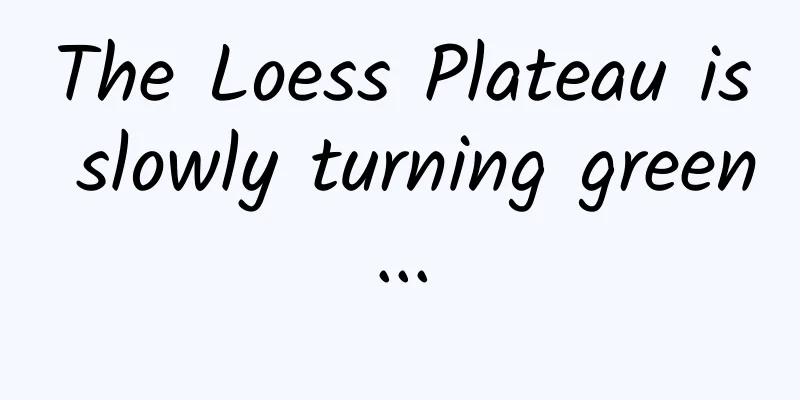The Loess Plateau is slowly turning green...

|
Copyright image, no permission to reprint These thousands of ravines and gullies are now full of greenery. About 8 million years ago, there was a vast lake here. It starts from the Sun and Moon Mountain in Qinghai in the west, extends to Luoyang in Henan in the east, to the Qinling Mountains in Shaanxi in the south, and to the Great Wall of northern Shaanxi in the north. Its area is as large as 6 Bohai Seas today. The lake is vast and the water is like an ocean, so it is called the Loess Lake . During that period, the weather on Earth was dry and cold, with strong winds blowing everywhere. The strong winds blew up sand and dust from the desert on the west bank of the lake. After millions of years of wind blowing, dust accumulated at the bottom of the lake. From west to east, the soil layer changed from coarse to fine, and the soil at the bottom of the lake became thicker and thicker. Copyright image, no permission to reprint With geological changes, the entire lake area was slowly lifted up, the lake bottom was raised, the lake water rushed down and flowed towards the East China Sea. The loess lake area became higher and higher, the lake water became less and less, until it dried up, leaving only the loess high slope landform . The "soil" of the Loess Plateau has a history of tens of thousands of years, but now it is time for a change. 01 Loess Plateau Earth in Feng Shui The Loess Plateau is located in the north-central part of China. It is one of the four major plateaus in China . It is more than 1,000 kilometers long from east to west and 750 kilometers wide from north to south. It includes a vast area west of the Taihang Mountains in China, east of the Riyue Mountains in Qinghai Province, north of the Qinling Mountains, and south of the Great Wall. It is located on the second-level terrace of China , with an altitude of 800 to 3,000 meters. Copyright image, no permission to reprint The Loess Plateau is a type of aeolian landform . The monsoon formed after the uplift of the Qinghai-Tibet Plateau continuously blew and transported dust from the desert areas of Central Asia to the middle reaches of the Yellow River, where it was deposited as a loess layer 50 to 400 meters thick. Loess is a wind-blown deposit accumulated in an arid and semi-arid environment. This soil is loose and easily permeable. In addition, the soil layer is thick and the groundwater level is buried deep. The climate here is a temperate continental monsoon climate with little precipitation and high evaporation . Soil moisture is the only water resource that vegetation can directly use, but due to the characteristics of loess, it is very fragile and difficult to survive. Vegetation degradation has aggravated soil erosion and formed today's Loess Plateau. Copyright image, no permission to reprint The Loess Plateau was once one of the areas with the most serious soil erosion and the most fragile ecology in my country and even in the world. Wind erosion and water erosion are the main forms of soil erosion here. Wind erosion is the blowing of dust by strong winds, such as sandstorms. The wind and sand on the Loess Plateau mainly come from the two major deserts in the Ordos region in the north - the Kubuqi Desert and the Mu Us Desert. Among them, the Mu Us Desert poses the greatest threat to counties and cities in central Ningxia and northern Shaanxi. Soil erosion intensity map of the Loess Plateau. Image source: "Analysis of ecological governance in the Loess Plateau over the past 60 years and suggestions for future development" The agricultural and pastoral boundary in northern Shaanxi was originally in the area of the Ming Great Wall. According to historical records, in the middle of the Ming Dynasty, quicksand crossed the Great Wall and besieged Yulin. "Sand accumulated up to the city, and yellow sand was everywhere. It was endless. Within a hundred miles, it was all desert with no grass." More than 30 years ago, half of the Ordos Plateau became sandy land, and the forest coverage rate was only 3%, becoming the largest source of sandstorms threatening the Loess Plateau. Kubuqi Desert. Copyrighted image, unauthorized reproduction Water erosion is caused by rainfall, which washes away the topsoil and deepens gullies. The most important and widespread of these is water erosion . The basic properties of loess, the steep and dense gully terrain, and the concentrated characteristics of heavy rain are the main natural factors for the severe soil erosion here. In addition, land reclamation and utilization are the main human factors that aggravate soil erosion. On the Loess Plateau, the border area between Shanxi, Shaanxi and Inner Mongolia is the area with the most severe soil erosion. However, in geological time, soil erosion is not always a bad thing. Copyright image, no permission to reprint About 150,000 years ago, the ancient Sanmenxia lake basin was cut through and the modern Yellow River system was formed. The silt from the loess area was carried downstream by the Yellow River and deposited into the vast North China Plain. Starting from the Yangshao Culture, the Loess Plateau has nurtured the Chinese nation for seven thousand years, and the tributaries of the Yellow River have fostered Chinese civilization. The book "Loess and the Origin of Chinese Agriculture" mentions that the ancient agricultural systems in the Mesopotamian, Nile, Indus and other regions of the Old World were based on floodplains and primitive irrigation, while my country's ancient agricultural system was completely different - it was composed of loess terraces in small river basins, dryland farming and standard "Chinese-type" crop combinations. Copyright image, no permission to reprint Therefore, the birthplace of Chinese culture may have been born in the Weihe River Basin in Shaanxi, the Fenhe River Basin in Shanxi and the western Henan region. In fact, if you look closely, the loess on the Loess Plateau is very peculiar . This kind of loess is hard and cemented , and can stand thousands of feet high without the need for slope protection. For example, people can live in a big hole just by digging it out, and there is no need for any support. The loess soil layer is extremely thick and the soil is loose, so fields can be opened up everywhere and cultivated deeply. Dryland farmland does not have to be made as smooth as a mirror like the paddy fields in the south. It can rise and fall according to the slope. Cave dwellings in northwest China. Copyrighted images from the photo library, no permission to reprint However, excess will inevitably lead to disaster. From the Western Zhou Dynasty to the Han and Tang Dynasties, after two thousand years of intensive development, the Loess Plateau suffered severe soil erosion, and by the Qing Dynasty the ecosystem was on the verge of collapse. In ancient times, Liupan Mountain was covered with dense forests and was one of the most ecologically sound areas on the Loess Plateau. The Yuan emperor Kublai Khan once spent his summers here. In 1842, when Lin Zexu was exiled to Xinjiang, he passed by and recorded in his "Journey to the Hegemony": "The sand and soil are all purple, and no trees grow, but there are thin grasses." During the Republic of China period, the problem of soil erosion on the Loess Plateau was even more shocking. There were many reasons for the collapse of the ecosystem here, including deforestation, blind reclamation, natural disasters, population pressure, etc., and the loess plateau was completely unprotected. Copyright image, no permission to reprint Some historical geographers believe that the loess was once covered with vast forests. However, geologists cautiously stated that the environment of the Loess Plateau should have alternated between dry steppe, desert steppe and forest steppe with the two climate types of dry and cold and warm and humid. It is very important to understand this point: there is no need to plant a forest in the grassland area. Thus, the dryland terraces that saved the Loess Plateau were born. 02 Loess Plateau Soil in Grass and Field In the ecological management of the Loess Plateau, building terraces , silt dams , afforestation and natural restoration of vegetation are the four main methods to control soil erosion. Analysis of ecological governance in the Loess Plateau over the past 60 years. Figure/Analysis of ecological governance in the Loess Plateau over the past 60 years and suggestions for future development Among them, the dryland terraces and silt dams on the Loess Plateau are particularly effective . This dryland terrace system is completely different from the terrace system in the south, which is full of moisture. It is both farmland and an efficient soil and water conservation project. Most of the terraces on the Loess Plateau were built in modern times and are concentrated in the southwest. Image source: National Geographic China, October 2017 The terraced fields should give people a watery feeling, just like the terraced fields in the south. There must be water conservation forests, and then springs, canals, villages, terraced fields, and rivers to form a rice-growing ecosystem. Yunnan Red River Terraces. Copyrighted image, unauthorized reproduction The terraces on the Loess Plateau are completely different from the steamy impression of the rice terraces in the south. They are magnificent and unobstructed, like marks left by countless sea invasions throughout the geological ages, stacked up layer by layer all the way to the top of the mountain . Terraced fields on the Loess Plateau. Copyrighted image, unauthorized reproduction Moreover, it is difficult to see water on the terraces on the Loess Plateau. So how do these terraces work? Take the terraced fields in Zhuanglang County, Gansu Province as an example. They are different from those in the north. There is a small forest of trees and shrubs on the top of the mountain. There are lush weeds on the ridges of the terraced fields on the mountainside. There is a silt dam at the bottom of the ditch. The terraced fields in each ditch valley - a small watershed in the natural geographical sense - are an independent unit. The trees and shrubs on the top of the mountain and the terraced fields on the hillside block water and soil. Even if there is any leakage, the silt dam at the foot of the mountain can be used for final interception. Terraced fields in Zhuanglang County. Copyrighted image, unauthorized reproduction The check dam is a very clever invention. The intercepted rainwater is usually used for irrigation. When there is too much silt accumulation, it is turned into fertile farmland, and a new check dam is built on top of it. Villages are scattered on the hillside, radiating from a network of roads and mechanized farming paths that extend in all directions; trees are densely planted along the ditches to stabilize the slopes; water cellars are built between the terraces to collect rainwater; in the fields, mulch film technology is used to prevent water evaporation, which has greatly increased the yield of potatoes and corn. If the core of the southern terraces is the control of irrigation water, then the terraces here rely on rainfall, forming a dryland farming system with water conservation and water saving as the core, which can achieve nearly 100% interception of soil erosion. Southern terraced fields. Copyrighted images from the photo library, unauthorized reproduction Zhuanglang County is a national-level poverty-stricken county in a loess gully area with high mountains and steep terrain. Since the first terraced fields were built in the winter of 1964, after 34 years of hard work, a total of 945,000 mu of horizontal terraces had been built by the end of 1997, accounting for 92% of the original sloping cultivated land area and 83% of the total cultivated land area. In 1998, the Ministry of Water Resources awarded Zhuanglang County the title of the first "China Model County for Terracing". The purpose of dryland terraces is to prevent the Loess Plateau from continuing to suffer from the harm of water erosion. In order to reduce wind erosion and fix quicksand, another method must be adopted - artificial sand barriers . In the Kubuqi Desert in Dalate Banner, Ordos City, Inner Mongolia, artificial sand barriers and vegetation restoration are used to control desertification. Copyright image, no permission to reprint This method includes laying grass grids and using terrain features to set up barriers. The grass grids are called the "Chinese Rubik's Cube" and are a successful experience in preventing and controlling desertification worldwide. All these have contributed to the Loess Plateau's getting rid of "soil". Ecological reconstruction has begun to show results. We are standing at a turning point in the environmental history of the Loess Plateau, watching it gradually turn green . Copyright image, no permission to reprint The Loess Plateau is finally not so earthy anymore. References: [1] Analysis of ecological governance in the Loess Plateau over the past 60 years and recommendations for future development [2] “Defending the Loess: Rebuilding the Ecology of the Loess Plateau” by Xiao Chunlei, National Geographic China, October 2017 [3] “Origin of the Loess Plateau”, Chinese Academy of Sciences, “CAS Online”, Science Wisdom Sparks column website Source: China National Geographic BOOK The cover image and the images in this article are from the copyright library Reproduction of image content is not authorized Please reply "repost" to repost the original text and pictures |
<<: Hydration and moisturizing! 90% of people fail this introductory course
>>: China's Sky Eye: Exploring the Mysteries of the Universe
Recommend
Electric Technology Car News: How to choose between Trumpchi GS8, Highlander Boyue and Tiguan domestic SUV
A few years ago, if you wanted to buy an SUV for ...
Eating more dietary fiber can help reduce inflammation levels in the body! Which foods have good anti-inflammatory effects?
Inflammation is the common "soil" for m...
Teach you how to clean up your phone's memory garbage correctly, clean up dozens of GB in an instant, save and clean up
When we use our mobile phones for a long time, th...
Do you think being a pig is easy? You can grow 1 pound of meat by eating 2 pounds of grain. Why don’t you try it?
Obtaining a stable food source is probably one of...
How to plan an event well? 4 key actions!
When it comes to event planning , perhaps in many...
Drools rule engine practice
Part 1 Rules Engine Rule engine: The full name is...
Humans eat this kind of food, causing male fish to change sex, birds to become extinct, and causing chaos in the animal world
In recent years, a mysterious phenomenon has been...
Technology News | Research finds genetic link between fingerprints and limb development
【Today’s cover】 Recently, the Nanxi River section...
How do brands plan their video account matrix?
Recently, we have observed that many brands have ...
The most creative collection of Mid-Autumn Festival posters is here!
Before the Mid-Autumn Festival comes, we have col...
Baidu promotion video information flow advertising display style - live broadcast
Information flow advertising style - live broadca...
The Great Voyages of Discovery丨Why do Chinese ancient ships stand out in the world?
Ships have evolved from prehistoric wood-cut boat...
E-commerce 618 | How to design posters for information flow promotion ads?
With the hot Internet e-commerce launching variou...
Some methods and techniques for choosing 400 telephone service
No matter what we do, if we find certain methods ...
Zhixing Research Society: A course for beginners to break through the thinking circle "Million Puzzle Project"
Zhixing Research Society: Novice Thinking Breakth...







![[Smart Farmers] Named after "Beauty"! Uncovering the secrets of the "civil and military" canna that migrated from the tropics](/upload/images/67f214ee8efcd.webp)

